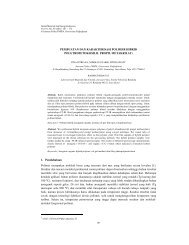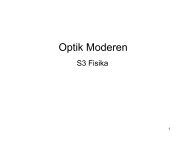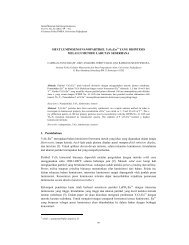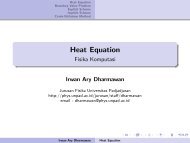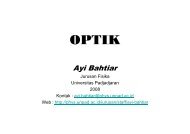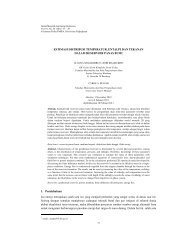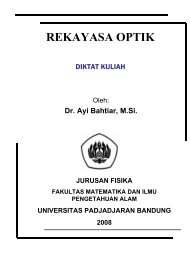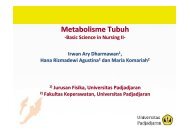Introduction to High-Performance Computing
Introduction to High-Performance Computing
Introduction to High-Performance Computing
Create successful ePaper yourself
Turn your PDF publications into a flip-book with our unique Google optimized e-Paper software.
<strong>Introduction</strong> <strong>to</strong><strong>High</strong>-<strong>Performance</strong> <strong>Computing</strong>Gerolf Ziegenhain – TU Kaiserslautern, Germany
Definitions - General Part
What is HPC?●●●●●HPC = <strong>High</strong>-<strong>Performance</strong> <strong>Computing</strong>~ Supercomputing<strong>High</strong> computer power for– Calculations– S<strong>to</strong>rage– <strong>High</strong> availabilityHPC: concentration on calculationsFastest high-performance computers <strong>to</strong>p500.orgNB: Ghz ≠ GFLOPS (Floating Point Operations)
Current Status (November 2009)<strong>to</strong>p500.org●IBM, HP, Cray dominate high-performance market
Vendors of the Fastest Computers●IBM, HP, Cray increased their domination<strong>to</strong>p500.org
Operating Systems● All POSIX ⇒ core environment similar<strong>to</strong>p500.org
●●POSIX ≠ W*nd0wsOperating Systems– Portable Operating System Interface [for UniX]"– Some POSIX OS●●●LinuxFreeBSD, OpenBSDSolaris, AIXWhere do POSIX like OS run?– Mobile phone– WIFI-router– GPS navigation system– Desk<strong>to</strong>p– HPC⇒ Key technology
Where Are the Clusters Located?<strong>to</strong>p500.org
Who Uses HPC?google.com
What Can Be Done With HPC?●●<strong>Performance</strong> / S<strong>to</strong>rage / <strong>High</strong> availabilityExamples:– Cluster / || computing (P,S)– Google (P, S, H)– Cloud-computing (P, S, H)– Webserver (S, H)– Phone (P, H)– Video (P, S, H)⇒ Key technology
Who Else Uses HPC?●Industry– Product development (material properties)– Research (simulation of crash tests)– Production (robotics, optimization)– Collaboration (world-wide)– Interaction with cus<strong>to</strong>mer (homebanking, call center)●●Universities– Research (biology, physics, chemistry, mathematics,engineering)Government– Infrastructure– Interaction citizen ↔ government
Cluster Architectures
Von Neumann-Architecture●CPU interacts with memory:●Speedup: multiple instructions at once– Pipelining– Pentium, PowerPC, Cell Processor (PS3), GPGPU●Multiple CPUs, one memory (shared memory)– SMP, vec<strong>to</strong>r computer●Multiple computers (distributed memory)– Transputer, cluster
How <strong>to</strong> Couple the CPUs?●●●Protected memory– I.e. multiple accessCluster filesystems– I.e. mixing local/distributed approachNetworking <strong>to</strong>pology– Depending on problem⇒ Coupling of CPUs depends on coupling of theproblem <strong>to</strong> solve
Cluster Types●●●Homogenous cluster– SupercomputersHeterogenous cluster– Old hardwareGrid computing– Screensaver → folding@home●Restriction: Here only AMD/Intel alike desk<strong>to</strong>p pcs⇒ Beowolf cluster
Examples of Decompositions
Physical Confinements●System ↔ Hardware ↔ Algorithm– Interaction, ρ({x}, t), Symmetry●Range of interaction– Short: decomposition with all-<strong>to</strong>-all-communication– Long: tree algorithms●●Density distribution– Homogenous system ⇒ balanced load betweennodesSymmetry– Choice of networking
Example - Strong Coupling●A<strong>to</strong>mistic simulation● Many particles ⇒ || simulation●●Parallelized in spaceInteraction– Width ⇒ R cut– Interaction of boundary particles⇒ Shared boundaries●Critical: Surface / Volume ratio⇒ Strong couplingZiegenhain 2009
Example - Weak Coupling●Problem:– Infrequent state– Low transition rate– But: full dynamics needed●Idea: use statistics <strong>to</strong> achieve transition– Parallel replicaZiegenhain 2007⇒ Weak coupling
Paradigm Change●●Algorithm can be decomposed innon-/parallelizable partsGeneral limit for parallelization:– Due <strong>to</strong> communication– S(p): speedup as function of #cpu– I.e. 100 painters brushing one room⇒ Amdahls Law (1967)● Gustavson (1988):Ziegenhain 2008– Decomposition of problem matters (system has <strong>to</strong>scale)– I.e. 100 painters brushing 100 rooms
What is a Beowolf Cluster?●●●Developed 1992 @ NASAIdea: Do not built supercomputer, but usecommon hardware!– Usual user-hardware PCs– Networking interconnectAdvantages– Use old pcs (heterogenous cluster)– Use CIP pool in the night– Usual staff-pcs in the night
Key technology: Hardware●Influence with industry– Ha-server– Cloud computing●Influence with infrastructure– Ha-server– E-government
How <strong>to</strong> Use Computers in Research?
What is Computersimulations?●Objective: description of the reality– Therefore: model systems● Simulation method ⇐ model system– There is no the computer simulation
Computer Simulations●Methodologic branches in science– Theory– Experiment– Simulations●●●●Missing linkLook at difficult-<strong>to</strong>-extract phenomenaExperimental observation / preparation not possibleTheory can only give approximative solution
Motivation for Simulations● Scientific● Test of model systems● Total control on parameters● Observables easily accessible● Economic● Cheap● Universal● General● (Dis-)advantage depends on method● Computation power still far <strong>to</strong> small <strong>to</strong> work without tricks● It's not always worthwhile <strong>to</strong> run a simulation
Simulations on Different Length Scales●For different scales● Different aspects of physics● Different model systems● Different simulation methods●Problematic: coupling of scales
Dimensions of Simulations●How long can a simulation run– Seconds → ∞– Usually: ~hours → ~days●How much data is created?– MByte → TByte– Usually: ~GByte
Global Experiment●●●●●∃ New chances through open source softwareUse remote clusterCloudApply for cpu time / s<strong>to</strong>rageWork from remote
What Can HPC Give <strong>to</strong> a University?●●●●Results achieved relatively easilyVisibility through open source contributionsWorldwide collaborations with EU / USASource for common problems / fields exists● Many application purposes ⇒ all departments mayshare a cluster●External computation can be used
●Industry– Clusters– Cloud– Web– Phone– TvBenefit for Country●●Reduction of administrative overheadCus<strong>to</strong>mer interactions
Scientific Benefit●●●●●Global experimentGrid computingRelatively easy <strong>to</strong> achieve new results becausethe field is newExact control over model system and parametersMissing link
Selection of Grand Challenges●Hydrodynamics– Design of bodies for aircraft & au<strong>to</strong>mobiles– Turbulence– Weather forecasting / estimating climate change●Plasma dynamics– Fusion energy●Symbolic computation– Speech recognition– Semantic data manipulation●Material science– Nanomaterials
The Big Picture●●●Next wave is comingWeb is revolutionary similar <strong>to</strong> book printingFree access <strong>to</strong> information
Key Technologies●●●HardwareOSSoftware
Zuse Z3 (1941)●●~ 0.3 Flops1 node, 2.600 relais● 176 byte memoryDeutsches Museum
Cray Jaguar (2009)●Cray Jaguar●●●2.3 Peta-Flops224.162 nodes, 8.4*10¹² gatesSpecial network, filesystemWikipedia
Thank you!●Acknowledgement:– Prof. Dr. rer. nat. Herbert M. Urbassek,TU Kaiserslautern, Germany






